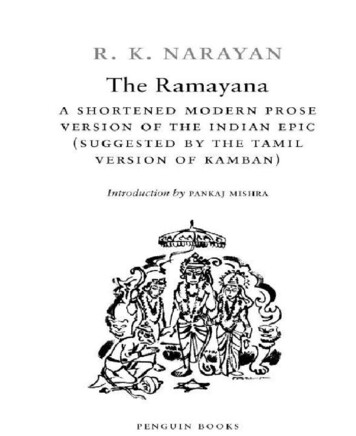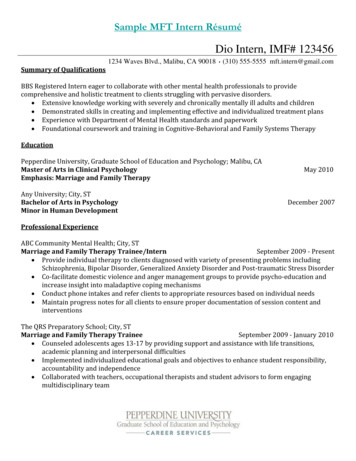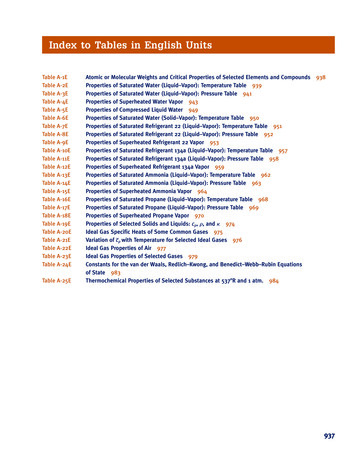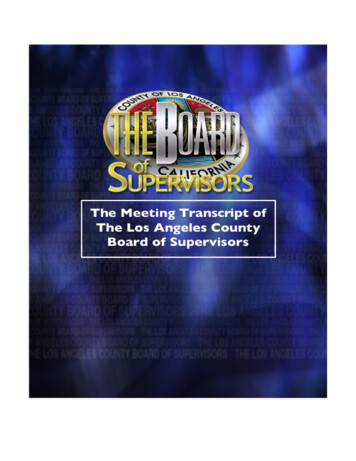
Transcription
Table of ContentsAbout the AuthorTitle PageCopyright PageIntroductionDedicationChapter 1 - RAMA’S INITIATIONChapter 2 - THE WEDDINGChapter 3 - TWO PROMISES REVIVEDChapter 4 - ENCOUNTERS IN EXILEChapter 5 - THE GRAND TORMENTORChapter 6 - VALIChapter 7 - WHEN THE RAINS CEASEChapter 8 - MEMENTO FROM RAMAChapter 9 - RAVANA IN COUNCILChapter 10 - ACROSS THE OCEANChapter 11 - THE SIEGE OF LANKAChapter 12 - RAMA AND RAVANA IN BATTLEChapter 13 - INTERLUDEChapter 14 - THE CORONATIONEpilogue
Glossary
THE RAMAYANAR. K. NARAYAN was born on October 10, 1906, in Madras,South India, and educated there and at Maharaja’s Collegein Mysore. His first novel, Swami and Friends (1935), and itssuccessor, The Bachelor of Arts (1937), are both set in thefictional territory of Malgudi, of which John Updike wrote,“Few writers since Dickens can match the effect of colorfulteeming that Narayan’s fictional city of Malgudi conveys; itspopulation is as sharply chiseled as a temple frieze, and asendless, with always, one feels, more characters round thecorner.” Narayan wrote many more novels set in Malgudi,including The English Teacher (1945), The FinancialExpert (1952), and The Guide (1958), which won him theSahitya Akademi (India’s National Academy of Letters)Award, his country’s highest honor. His collections of shortfiction include A Horse and Two Goats , Malgudi Days, andUnder the Banyan Tree . Graham Greene, Narayan’s friendand literary champion, said, “He has offered me a secondhome. Without him I could never have known what it is like tobe Indian.” Narayan’s fiction earned him comparisons to thework of writers including Anton Chekhov, William Faulkner,O. Henry, and Flannery O’Connor.
Narayan also published travel books, volumes of essays,the memoir My Days, and the retold legends Gods,Demons, and Others, The Ramayana,and TheMahabharata. In 1980 he was awarded the A. C. BensonMedal by the Royal Society of Literature, and in 1981 hewas made an Honorary Member of the American Academyof Arts and Letters. In 1989 he was made a member of theRajya Sabha, the nonelective House of Parliament in India.R. K. Narayan died in Madras on May 13, 2001.PANKAJ MISHRA is the author of The Romantics, winner ofthe Los Angeles Times ’s Art Seidenbaum Award for FirstFiction, An End to Suffering: The Buddha in the World, andTempations of the West: How to be Modern in India,Pakistan, Tibet, and Beyond . He is a frequent contributor tothe New York Times Book Review, the New York Review ofBooks, and the Guardian.
PENGUIN BOOKSPublished by the Penguin GroupPenguin Group (USA) Inc., 375 Hudson Street, New York, New York 10014,U.S.A.Penguin Group (Canada), 90 Eglinton Avenue East, Suite 700, Toronto,Ontario, Canada M4P 2Y3 (a division of Pearson Penguin Canada Inc.)Penguin Books Ltd, 80 Strand, London WC2R 0RL, EnglandPenguin Ireland, 25 St Stephen’s Green, Dublin 2, Ireland (a division ofPenguin Books Ltd)Penguin Group (Australia), 250 Camberwell Road, Camberwell,Victoria 3124, Australia (a division of Pearson Australia Group Pty Ltd)Penguin Books India Pvt Ltd, 11 Community Centre, Panchsheel Park, NewDelhi - 110 017, IndiaPenguin Group (NZ), cnr Airborne and Rosedale Roads, Albany,Auckland 1310, New Zealand (a division of Pearson New Zealand Ltd)Penguin Books (South Africa) (Pty) Ltd, 24 Sturdee Avenue,Rosebank, Johannesburg 2196, South AfricaPenguin Books Ltd, Registered Offices:80 Strand, London WC2R 0RL, EnglandFirst published in the United States of America by The Viking Press 1972First published in Great Britain by Chatto & Windus 1973Published in Penguin Books (U.S.A.) 1977Published in Penguin Books (U.K) 1977This edition with an introduction by Pankaj Mishra published in PenguinBooks (U.S.A.) 2006Copyright R. K. Narayan, 1972Introduction copyright Pankaj Mishra, 2006All rights reservedThe decorations, drawn from Indian temple sculptures, are by R. K. Laxman.LIBRARY OF CONGRESS CATALOGING IN PUBLICATION DATA
Narayan, R. K., 1906-2001.The Ramayana : a shortened modern prose version of the Indian epic(suggested by the Tamil version ofKamban) / R.K. Narayan ; introduction by Pankaj Mishra.p. cm.—(Penguin classics)eISBN : 978-0-143-03967-91. Rama (Hindu deity)—Fiction. 2. Epic literature, Tamil—Adaptations. I.Kampar, 9th cent.Ramayanam. II. Title. III. Series.PR9499.3.N3R36 2006297.5’922—dc22 2006045201The scanning, uploading and distribution of this book via the Internet or viaany other meanswithout the permission of the publisher is illegal and punishable by law.Please purchaseonly authorized electronic editions, and do not participate in or encourageelectronicpiracy of copyrighted materials. Your support of the author’s rights isappreciated.http://us.penguingroup.com
IntroductionIn the summer of 1988 sanitation workers across North Indiawent on strike. Their demand was simple: they wanted thefederal government to sponsor more episodes of atelevision serial based on the Indian epic Ramayana(Romance of Rama). The serial, which had been running onIndia’s state-owned television channel for more than a year,had proved to be an extraordinarly popular phenomenon,with more than eighty million Indians tuning in to every weeklyepisode. Streets in all towns and cities emptied on Sundaymornings as the serial went on the air. In villages with noelectricity people usually gathered around a rented televisionset powered by a car battery. Many bathed ritually andgarlanded their television sets before settling down to watchRama, the embodiment of righteousness, triumph overadversity.When the government, faced with rising garbage moundsand a growing risk of epidemics, finally relented andcommissioned more episodes of The Ramayana, not justthe sanitation workers but millions of Indians celebrated.More than a decade and many reruns later, the serialcontinues to inspire reverence among Indians everywhere,and remains for many the primary mode of experiencingIndia’s most popular epic.The reasons for this may not be immediately clear to an
uninitiated outsider: the serial, cheaply made by a Bollywoodfilmmaker, abounds in ham acting and tinselly sets, and thelong, white beards of its many wise, elderly men lookperilously close to dropping off.But it wasn’t so much its kitschy, Bollywood aspect thatendeared the serialization to Indians as its invoking of whati s easily the most influential narrative tradition in humanhistory: the story of Rama, the unjustly exiled prince. It maybe impossible to prove R. K. Narayan’s claim that everyIndian “is aware of the story of The Ramayana in somemeasure or other.” But it will sound true to most Indians.Indeed, the popular appeal of the story of Rama amongordinary people distinguishes it from much of Indian literarytradition, which, supervised by upper-caste Hindus, hasbeen forbiddingly elitist.There is really no Western counterpart in either theHellenic or Hebraic tradition to the influence that thisoriginally secular story, transmitted orally through manycenturies, has exerted over millions of people. The Iliad andThe Odyssey are, primarily, literary texts, but not evenAesop’s fables or the often intensely moral Greek mythsshape the daily lives of present-day inhabitants of Greece. Incontrast, The Ramayana continues to have a profoundemotional and psychological resonance for Indians.By invoking the utopian promise of Rama-Rajya (kingdomof Rama), Gandhi attracted a large mass of apolitical people
to the Indian freedom movement against the British.Postcolonial India may not resemble Rama-Rajya, but theemotive appeal of Ramayana seems to be undiminished,and often vulnerable to political exploitation: in the lateeighties and early nineties, the Hindu nationalist movementto build a temple on the alleged birthplace of Rama claimedthousands of lives across India.Like millions of other children, I first heard the story of Ramafrom my parents. Or so I think: I can’t remember a time whenI did not know it. Religious occasions at home began with arecital of the Ramacharitamanas, the long sixteenth-centurydevotional poem based on the story of Rama. All the olderpeople I knew were only two or three decades away fromvillage life, and they had memorized the verses in theirchildhood. I remember my elder sisters arguing with themabout just how righteous Rama was when he killed a monkeyking in cold blood or forced his wife, Sita, to undergo a testof chastity after her return from captivity.Every autumn, I looked forward to Diwali, the mostimportant Indian festival, which commemorates Rama’sreturn from exile, and which children in particular love since itgives them an opportunity to buy new clothes andfirecrackers and eat sweets. Autumn was also the time oft h e Ramleela, the folk pageant-play based on Rama’sadventures, which is performed even today in not only all
North Indian small towns and cities but also in the remote FijiIslands and Trinidad, where descendents of nineteenthcentury Indian immigrants try to hold on to their cultural linkswith their mother country.I remember the performers with bare torsos, walking in anexaggerated, mincing style on their toes; Hanuman “flying”across the stage on a transparent wire; and, at the end of tendays, the burning of the big ten-headed tinsel effigy ofRavana. Armed with a bamboo bow and arrow, I imaginedmyself to be Rama, pursuing the forces of disorder. But itwas only later I realized that though there is much of thefairytale in The Ramayana to engage the child—the princethrown upon fate, the kidnapped princess, flying monkeys—italso has a complex adult and human aspect. Far fromrepresenting a straightforward battle between good and evil,it raises uncomfortable ethical and psychological questionsabout human motivation; it shows how greed and desire rulehuman beings and often make them arrogant and prone toself-deception. Even the idealized figure of Rama hintsparadoxically at the difficulty of leading an ethical life.Most versions of Rama’s story begin with Dasaratha, theheir-less king of Kosala who, on the urging of his spiritualadvisors, performs a sacrificial ritual that enables his threewives to conceive sons. The firstborn, Rama, is the ablestand most popular of Dasaratha’s offspring, who proves his
superiority by stringing an enormous bow others can barelylift and by winning his bride, Sita.When Dasaratha decides to retire from worldly duties, hechooses Rama as his successor. This greatly dismays hissecond wife, who wants her own son to be king. Just as thecoronation of Rama is about to begin, she asks her husbandto redeem two boons he had once made to her at a weakmoment in his life. She demands that Rama be banishedfrom Ayodhya for fourteen years and her son be anointedking in his place.Dasaratha is deeply distraught by this unreasonabledemand. But he is unable to refuse her—to keep one’s vowis deemed one of the highest moral achievements in TheRamayana. Similarly, it is part of Rama’s virtue to beobedient to and unquestioning of his parents. He accepts hisfather’s decision and, accompanied by his wife, Sita, andhalf-brother Lakshmana, he abandons Ayodhya, much to thegrief of its inhabitants.Traveling through forests, Rama and his companions havemany adventures. But none proves more dramatic thanRama’s encounter one day with a demoness calledSoorpanaka. She falls in love with Rama and proposesmarriage to him, and then concludes that Sita’s great beautyis to blame for his indifference to her. When she tries toattack Sita, Lakshmana mutilates her. Soopanaka flees toher brother Ravana, the all-powerful demon king of the island
of Lanka, and tells him of the cruelty inflicted upon her.The accounts of Sita’s beauty stir Ravana’s curiosity anddesire. He arranges for a distraction that draws Rama andLakshmana away from her hermitage. Then, dressed as aholy man, Ravana manages to enter Sita’s dwelling andkidnaps her.Now begins Rama’s pursuit of Ravana, which leads him tounexpected friends and allies in a monkey kingdom. Hismost devout monkey ally, Hanuman, crosses the ocean toLanka and alerts Sita that help is on the way. Hanuman alsoallows himself to be captured and produced in Ravana’scourt. Ravana disregards his warning of impending doom atthe hands of Rama and orders Hanuman’s tail to be setalight. But Hanuman escapes and, in the process, sets all ofLanka on fire. On his return, he helps Rama plan for theinevitable assault on Lanka, which comes after the monkeyarmy builds a bridge over the ocean to the island.After a long and bloody battle, Rama kills Ravana and hisclosest associates. But he suspects that Sita’s virtue has notsurvived her long confinement in Lanka and refuses toaccept her. A distraught Sita undergoes a trial by fire inorder to prove her chastity, and survives. A chastened Ramareturns with her to Ayodhya to be crowned king. But doubtsabout Sita’s virtue haunt him and when he hears of rumorsagainst her among the general public he banishes her fromhis kingdom. In exile she gives birth to two sons. Not long
after this, she passes away, and a bereft and heartbrokenRama decides to join her in heaven.This is the basic story on which many variations have beenmade through the centuries. It is not clear when it first cameinto being: bardic literature that has been orally transmittedcannot be precisely dated. Moreover, the story of Rama hasproliferated bewilderingly across India and Southeast Asia. Itexists in all major Indian languages, as well as Thai, Tibetan,Laotian, Malaysian, Chinese, Cambodian, and Javanese. Inplaces as remote from India as Vietnam and Bali, it hasbeen represented in countless textual and oral forms,sculpture, bas-reliefs, plays, dance-drama, and puppetplays.Little is known about the poet Valmiki, who apparentlywrote the first narrative in Sanskrit, probably around thebeginning of the Christian era. Many Indians considerValmiki’s Ramayana to be the standard version, and it isstill presented as such in many translations into English. Butits version of Rama’s story has been repeatedly challenged,repudiated, or simply ignored in multiple artistic forms thatoriginate not so much from an ur-text as from what the Indianpoet and critic A. K. Ramanujan called an “endemic pool ofsignifiers (like a gene pool).”1Valmiki presented an idealized, if not beatified, image ofRama, establishing the basis for his popular reverence.
Later versions present Rama as an incarnation of LordVishnu, the principal Hindu deity who helps preserve moralorder in the world, giving epic literature a sacred dimension,and helping make The Ramayana part of the cult of Vishnu,one of the major cults of popular Hinduism. But many ofthese versions, reflecting as they do the social diversity ofIndia, contradict one another, often self-consciously. In theversion preferred by Jains, an Indian sect organized aroundthe principles of asceticism, Ravana is a sympatheticcharacter, and Rama and Sita end up as world-renouncingmonk and nun, respectively. The devotional rasik tradition inNorth India focuses on the marriage of Rama and Sita andignores most of the events before and after it. Thenineteenth-century Anglicized Bengali writer MichaelMadhusudan Dutt chose to exalt Ravana over Rama in along narrative poem. Ravana remains one of the heroes oflow-caste Dalits in Maharashtra.The many Ramayanas also reflect the ideologies of theirtime: like most influential literature, The Ramayana hasnever been exempt from the struggles for political power.This became clearer after the eighth century A.D. as smallkingdoms arose in India, and rulers sought legitimacythrough association with the cult of Rama, the supposedlyideal king (the practice continues in Thailand, where ninekings in the previous two centuries have called themselvesRama). Even during the long centuries of Muslim rule overIndia, people used The Ramayana to project the view of
their particular social group. The Ramacharitamanas, thework of a North Indian Brahmin called Tulsi Das, laments thedecay of caste hierarchy and the rise of low-caste men topositions of influence: a state of affairs that for Tulsi standsin distinctive contrast to the situation in the kingdom of Ramawhere everyone knew his place.Not surprisingly, The Ramayana has invited its share ofpolitically motivated critics. The South Indian activist E. V.Ramasami saw it as a tool of North Indian upper-castedomination. In an essay in 1989, the distinguished Indianhistorian Romila Thapar claimed that the televisedRamayana was an attempt to create a pan-Indian versionfor the more homogeneous modern age—one that India’sambitious and politically right-wing middle class could easilyconsume. In retrospect, Thapar seems to have been provedright: the television serial’s immense popularity set the stagefor the violent Hindu nationalist campaigns, in which Ramaappeared as Rambo, his delicate features and gentle smilereplaced by a muscular mien and grimace, and TheRamayana itself became a central text in the nationalists’attempt to weld Hinduism’s plural traditions into amonotheistic religion.R. K. Narayan was most certainly exposed to a benignversion of The Ramayana in his childhood. He would havefirst imbibed it through the classical tradition of Carnaticmusic, the calendar-art images and gemstone-set portraits
of Rama and Sita that are commonly found in bourgeoisSouth Indian homes, and the great literary classic in theTamil language, Kamba Ramayana.But it took him some decades to get around to writing hisown version of The Ramayana. Born in 1906 into a rising,urban family of Tamil Brahmins, which sought to enter, withone foot planted in tradition, the colonial Indian world of jobsand careers, Narayan had, as a young man, a bolderambition than anyone around him could have possessed. Hewanted to be a “realistic fiction writer” at a time whenrealistic fiction writers in English were almost entirelyunknown in India. It is partly why he was, as he relates in hismemoir, My Days (1974), indifferent to the classical Tamilliterature his uncle wanted him to read.Not surprisingly, Narayan wrote his abridged version ofThe Ramayana and The Mahabharata only in theseventies, after having produced some of his finest fiction:Swami and Friends (1935), The Financial Expert (1952),Waiting for the Mahatma (1955), The Guide (1958), andThe Vendor of Sweets (1967). “I was impelled,” he oncesaid, “to retell the Ramayana and the Mahabharatabecause that was the great climate in which our culturedeveloped. They are symbolic and philosophical. Even asmere stories they are so good. Marvellous. I couldn’t helpwriting them. It was part of the writer’s discipline.”2The writerly compulsion Narayan expresses through his
choice of words—“impelled,” “couldn’t help”—seems to havebeen greater than the one felt by a storyteller alighting upongood material. There is a mythic and religious dimension toNarayan’s later fiction, in which acts of personal devotion,self-effacement, and renunciation become a shield againstthe hard demands and uncertainties of the modern,impersonal world.This religious aspect of Narayan is explicit in hisRamayana. His admiration for Rama as a cultural andsocial ideal is clear throughout the book. It leads him topreface his chapter on the controversial killing of the monkeyking with these rueful words.Rama was an ideal man, all his faculties in control in anycircumstances, one possessed of an unwavering sense ofjustice and fair play. Yet he once acted, as it seemed, out ofpartiality, half-knowledge, and haste, and shot anddestroyed, from hiding, a creature who had done him noharm, not even seen him.3Rama’s cruelty to Sita at the end of his battle with Ravana isone of the strangest episodes in The Ramayana—onewhich directly challenges Rama’s image as an exemplarymoral being. In fact, the Tamil poet Kamban, Narayan’sliterary inspiration, makes Rama say some unsettlingly harshthings to Sita.
You stayed content in that sinner’s city, enjoying your foodand drink. Your good name was gone but you refused to die.How dared you think I’d be glad to have you back?4But Narayan drops Kamban’s account at this crucial momentin the book and chooses to bring in Valmiki’s much moremoderate version of Rama’s decidedly odd behavior. It is asthough he cannot fully acknowledge Rama’s lapse intocruelty, although such an omission may also be due toNarayan’s aversion to scenes of overt violence, verbal orphysical—an aversion that his fiction with its carefulavoidance of extremity makes clear.Happily, Narayan doesn’t linger much over battle scenes,where his prose seems to be weighed down byuntranslatable archaisms. The realistic fiction writer in him ismore at ease with the detail of everyday life. Here is adescription of the great crowd walking to attend Rama’swedding.Another young man could not take his eyes off the lightlycovered breast of a girl in a chariot; he tried to keep aheadof it, constantly looking back over his shoulder, unaware ofwhat was in front, and bumping the hindquarters of theelephants on the march.5Many of Narayan’s virtues familiar to us from his fiction are
present in this retelling of The Ramayana—particularly anEnglish prose so lucid and lightly inflected that it loses itsforeign associations and seems the perfect medium of swiftand action-packed storytelling. Indeed, The Ramayanacontains some of Narayan’s finest prose set-pieces. Here ishow he describes the end of the monsoons:Peacocks came out into the sun shaking off cloggingdroplets of water and fanning out their tails brilliantly. Riverswhich had roared and overflowed now retraced their modestcourses and tamely ended in the sea. Areca palms ripenedtheir fruits in golden bunches; crocodiles emerged from thedepths crawling over rocks to bask in the sun; snailsvanished under slush, and crabs slipped back under ground;that rare creeper known as vanji suddenly burst into bloomwith chattering parrots perched on its slender branches.6And so instinctively scrupulous and fair-minded is Narayanas a writer that not only Rama but also Ravana emerges asa fully rounded, even somewhat sympathetic, character.Though a dedicated sensualist, Ravana does not seemintrinsically bad or evil. Narayan shows clearly how he is ledastray by greed, and then succumbs to the particular illusionof power: the dream of perpetual dominance. As his youngerbrother, who defects to Rama’s side, tells him,
“You have acquired extraordinary powers through your ownspiritual performances but you have misused your powersand attacked the very gods that gave you the power, andnow you pursue evil ways. Is there anyone who hasconquered the gods and lived continuously in that victory?”7How often in Narayan’s fiction does one come across asimilar pragmatic realism, a gentle refusal to regard goodand evil as unmixed, and a melancholy sense of the reallimitations of life? It is this ethical and spiritual outlook thatattracted countless people to The Ramayana for more thana millennium. In Narayan—the sage of Malgudi who alwaysknew how to connect our hectic and fraught present to abarely remembered past—this ancient tale found its perfectmodern chronicler.NOTES1 A. K. Ramanujan, Paula Richman, ed., “Three HundredRamayanas,” Many Ramayanas (New Delhi: OxfordUniversity Press, 1992), 46.2 R. K. Narayan, The Indian Epics Retold: The Ramayana,The Mahabharata, Gods, Demons, and Others (New Delhi:Penguin, 2000), xi.3 R. K. Narayan, The Ramayana (New York: Penguin,2006),90.
4 P. S. Sundaram, trans., N. S. Jagannathan, ed., TheKamba Ramayana (New Delhi: Penguin, 2002), 387.5 Narayan, The Ramayana, 29.6 Ibid., 109.7 Ibid., 126.
Books by R. K. NarayanNOVELSSwami and Friends (1935)The Bachelor of Arts (1937)The Dark Room (1938)The English Teacher (1945)Mr. Sampath—The Printer of Malgudi (1949)The Financial Expert (1952)Waiting for the Mahatma (1955)The Guide (1958)The Man-Eater of Malgudi (1961)The Vendor of Sweets (1967)The Painter of Signs (1976)A Tiger for Malgudi (1983)Talkative Man (1986)The World of Nagaraj (1990)SHORT FICTION*Dodu and Other Stories (1943)*Cyclone and Other Stories (1945)An Astrologer’s Day and Other Stories (1947)*Lawley Road and Other Stories (1956)A Horse and Two Goats (1970)Malgudi Days (1982)Under the Banyan Tree and Other Stories (1985)
The Grandmother’s Tale and Selected Stories (1993)* Published in India onlyRETOLD LEGENDSGods, Demons, and Others (1964)The Ramayana (1972)The Mahabharata (1978)MEMOIRMy Days: A Memoir (1974)NONFICTION*Mysore (1939)*Next Sunday: Sketches and Essays (1960)*My Dateless Diary: An American Journey (1964)*Reluctant Guru (1974)*The Emerald Route (1977)*A Writer’s Nightmare: Selected Essays 1958-1988 (1988)*A Story-Teller’s World (1989)*Indian Thought: A Miscellany (1997)*The Writerly Life: Selected Non-fiction (2001)
* Published in India only
To the memory of my uncleT. N. Seshachalamwho had steeped himself inKamban’s Ramayana, and who expresseda last wish that I should continue the study
Valmiki the poet explained to Rama himself: “Owing to thepotency of your name, I became a sage, able to view thepast, present, and future as one. I did not know your storyyet. One day Sage Narada visited me. I asked him, ‘Who isa perfect man—possessing strength, aware of obligations,truthful in an absolute way, firm in the execution of vows,compassionate, learned, attractive, self-possessed,powerful, free from anger and envy but terror-striking whenroused?’ Narada answered, ‘Such a combination ofqualities in a single person is generally rare, but one such isthe very person whose name you have mastered, that is,Rama. He was born in the race of Ikshvahus, son of KingDasaratha .’ ” And Narada narrated the story of Rama.
IntroductionThe Indian epic, the Ramayana, dates back to 1500 B.C.according to certain early scholars. Recent studies havebrought it down to about the fourth century B.C. But all dates,in this regard, can only be speculative, and the later onedoes not diminish in any manner the intrinsic value of thegreat epic. It was composed by Valmiki in the classicallanguage of India—Sanskrit. He composed the whole work,running to twenty-four thousand stanzas, in a state of pureinspiration.1 It may sound hyperbolic, but I am prepared tostate that almost every individual among the five hundredmillions living in India is aware of the story of the Ramayanain some measure or other. Everyone of whatever age,outlook, education, or station in life knows the essential partof the epic and adores the main figures in it—Rama andSita. Every child is told the story at bedtime. Some study itas a part of religious experience, going over a certainnumber of stanzas each day, reading and rereading thebook several times in a lifetime. The Ramayana pervadesour cultural life in one form or another at all times, it may beas a scholarly discourse at a public hall, a traditional storyteller’s narrative in an open space, or a play or dance-dramaon stage. Whatever the medium, the audience is always aneager one. Everyone knows the story but loves to listen to itagain. One accepts this work at different levels; as a mere
tale with impressive character studies; as a masterpiece ofliterary composition; or even as a scripture. As one’sunderstanding develops, one discerns subtler meanings; thesymbolism becomes more defined and relevant to the daytoday life. The Ramayana in the fullest sense of the termcould be called a book of “perennial philosophy.”The Ramayana has lessons in the presentation ofmotives, actions and reactions, applicable for all time andfor all conditions of life. Not only in areas of military, political,or economic power do we see the Ravanas—the evilantagonists—of today; but also at less conspicuous levelsand in varying degrees, even in the humblest social unit orfamily, we can detect a Rama striving to establish peaceand justice in conflict with a Ravana.The impact of the Ramayana on a poet, however, goesbeyond mere personal edification; it inspires him tocompose the epic again in his own language, with the stampof his own personality on it. The Ramayana has thus beenthe largest source of inspiration for the poets of Indiathroughout the centuries. India is a land of many languages,each predominant in a particular area, and in each one ofthem a version of the Ramayana is available, original andbrilliant, and appealing to millions of readers who know thelanguage. Thus we have centuries-old Ramayana in Hindi,Bengali, Assamese, Oriya, Tamil, Kannada, Kashmiri,Telugu, Malayalam, to mention a few.
The following pages are based on a Tamil version of theepic written by a poet called Kamban of the eleventh centuryA.D. Tamil is a Dravidian language of great antiquity, with itsown literature and cultural values, spoken by over fortymillions who live in south India.2Kamban is said to have spent every night in studying theoriginal in Sanskrit by Valmiki, analytically, with the help ofscholars, and every day in writing several thousand lines ofhis own poetry. Of his task in assimilating Valmiki in theoriginal and reinterpreting him in Tamil verse, Kamban says,“I am verily like the cat sitting on the edge of an ocean ofmilk, hoping to lap it all up.”Etched on palm leaves, Kamban’s work, running to tenthousand five hundred stanzas, must have mounted into anenormous pile, as my own copy in a modern edition is in sixparts, each of a thousand pages (with annotation andcommentaries).I have taken for my narration several contiguous sectionsof Kamban’s work. Mine is by no means a translation nor ascholarly study, but may be called a resultant literary productout of the impact of Kamban on my mind as a writer. As a
fiction writer, I have enjoyed reading Kamban, felt thestimulation of his poetry and the felicity of his language,admired the profundity of his thought, outlook,characterization, and sense of drama; above all the love andreverence he invokes in the reader for his main figure, Rama—who is prese
THE RAMAYANA R. K. NARAYAN was born on October 10, 1906, in Madras, South India, and educated there and at Maharaja’s College in Mysore. His first novel, Swami and Friends (1935), and its successor, The Bachelor of Arts (1937), are both set in the fi










